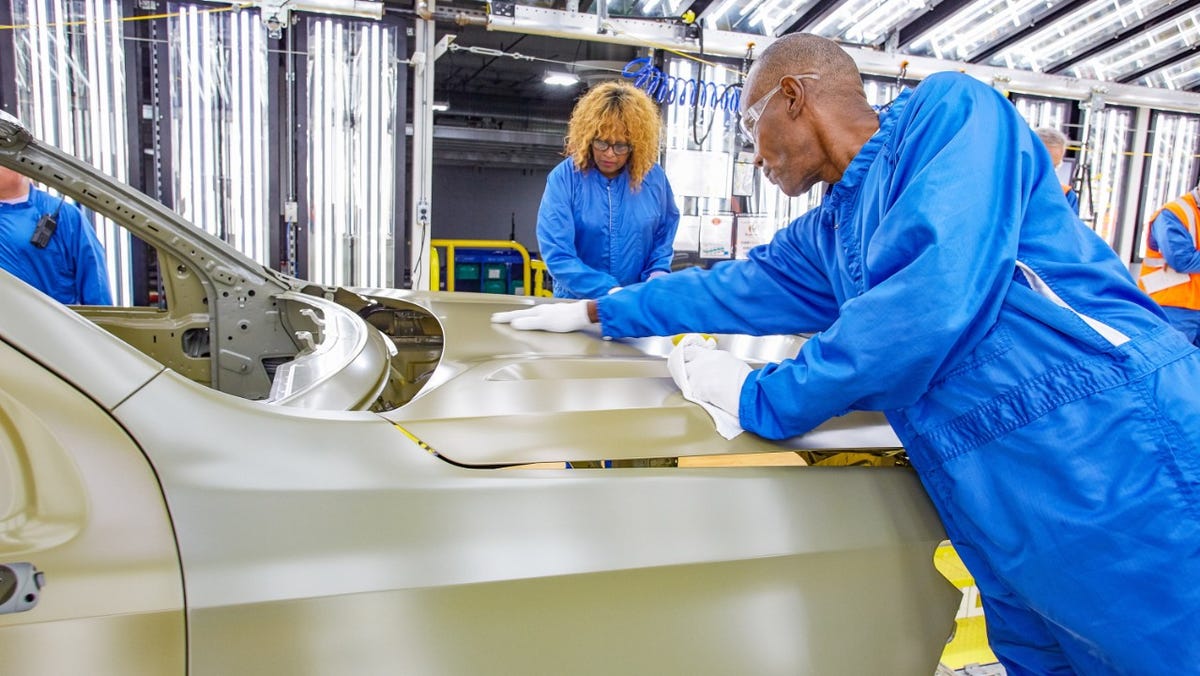INTERNET MARKETING NEWS
Will electric vehicles mean fewer auto manufacturing jobs? GM’s shift to EVs worries union
Electric cars on way, but buyers may not be readySome automakers are staking their futures on the notion that consumers will soon be ready to buy electric vehicles. The risk is as hazardous as it is simple: What if consumers reject EVs for many years to come? (March 15)APAt the General Motors Arlington Assembly plant in Texas, many of the 5,000 hourly workers worry about their job security even as they work long hours pushing out thousands of vehicles a week to meet robust consumer demand.GM builds the Cadillac Escalade, GMC Yukon, Chevrolet Tahoe and Chevrolet Suburban full-size SUVs at the Arlington factory.All of those trucks are propelled by gasoline, and they are all hot — for now.But in 15 years or sooner, these gasoline-fueled top-sellers will be obsolete. In fact, by 2030, GM said Cadillac will offer only electric vehicles, leaving many of Arlington’s hourly workers haunted by the vexing question: Which plant will get to build the electric Escalade as GM phases out the internal combustion model? Whoever does, wins job security — and Arlington wants it.Save better, spend better: Money tips and advice delivered right to your inbox. Sign up hereStimulus check update: When will ‘plus-up’ payments arrive? Answers to your COVID relief questions“GM plans years in advance,” Arlington’s UAW Local 276 Shop Chairman Kenny Hines said in an interview with the USA TODAY Network’s Detroit Free Press. “So if electrification of all Cadillacs is coming, someone has to be talking about it. Arlington people want to see something put in our plant for electric vehicles.”The shift to EVs carries uncertainty when it comes to the fate of the engineers who have spent their careers designing internal combustion engines, down to the factory workers who assemble the vehicles that use those engines.GM said it has a plan for the transition to an all-EV future that includes bringing all of GM’s employees along. Some are already being trained and making the transition.While many workers can be retrained to work on EVs, the fact remains that EVs require less parts. That will ultimately mean job loss, experts say, noting that EVs don’t use engines at all, potentially shuttering engine plants and the thousands of jobs inside the factory walls.“It takes fewer workers to manufacture an electric vehicle versus an internal combustion car — 30% to 40% less,” said Harley Shaiken, a business expert who teaches at the University of California, Berkeley. “That’s a huge change.”’Unknown is scary’About 35,000 hourly jobs could perish across the car industry as GM and other automakers move to EVs, said Marick Masters, a Wayne State University business professor who specializes in labor issues and has studied the potential impact of transitioning to EVs.GM has said all of its light-duty vehicles will be zero-emissions by 2035 and that GM will be a carbon neutral company by 2040. For Cadillac dealers who don’t want to make a quarter-million-dollar investment to sell EVs by 2030, GM’s offered them buyouts. About 270 have taken GM up on it — there goes some dealership jobs. GM has also hinted that dealership sales and service will change with the transition to EVs, which is likely to impact dealership jobs, too.There’ll be fewer jobs all the way from the supply chain down to the dealers, Shaiken said.”At a dealership, no more oil changes, fewer catalytic converters and the companies have given hints that dealerships will be redefined,” Shaiken said.As for its hourly workforce, plants like Arlington that produce internal combustion engine cars would likely keep doing so even if GM allocates an EV to the plant, at least for a while.When GM announced that it would build the new Cadillac Lyriq electric SUV at Spring Hill Assembly plant in Tennessee, it said: “Production of the Cadillac XT6 and XT5 will continue at Spring Hill. The facility will build both traditionally powered Cadillac products and EVs.”GM is investing $4.5 billion to retool Spring Hill, Factory ZERO in Detroit and Hamtramck and Orion Assembly in Orion Township to make EVs.GM has assigned four EVs to Factory ZERO and said when its running at full capacity, the plant will employ 2,200 people. It starts building the GMC Hummer EV pickup this fall and will eventually get the electric version of the Chevrolet Silverado pickup. But there’s been no news on future investments at Arlington.“Most of our members are just worried about the future,” Hines said. “What are electric vehicles going to do to their jobs? It may have no impact at all, but just the unknown is scary.”Accelerating job lossPut simply: It requires less manpower to build an EV.The typical internal combustion engine has about 2,000 parts in it, Masters said. Whereas EVs use far fewer parts, some parts might be bigger such as batteries, but fewer people are needed overall to make EVs.”There will be some job loss,” Masters said. “The question is how much of that can be mitigated?” If the move to EVs is accelerated by politicians pushing to control climate change and improve infrastructure with more charging stations, that will only hasten the “dislocation of jobs,” Masters said.“I think anybody has reason to be worried,” Masters said. “You also have to factor in how popular are electric vehicles going to be to foreign competitors, what is the cost to make them, how profitable will they be versus internal combustion … all of that impacts the performance of the company and that will impact jobs, too.”GM has partnered with EVgo, the largest public fast-charging network for EVs, to triple the size of the U.S.’ public fast-charging network to help boost EV adoption. Also, a California executive order requires that by 2035, all new vehicles sold in the state be zero-emission vehicles. That will speed up EV adoption there, and likely elsewhere considering California’s considerable influence across the nation.California is by far the biggest car market in the country, said Michelle Krebs, executive analyst at Autotrader. It accounted for 11% of all new vehicles sold in the U.S. last year and 11.6% of the total new retail vehicle market. More than a quarter of all EVs and hybrids sold in the U.S. are sold in California, Krebs said.Ever conscious of that are the politicians in Washington, D.C. President Joe Biden has proposed a massive $2 trillion infrastructure package that includes a big push for EVs with tax credits, consumer rebates and other incentives to encourage EV adoption. The UAW has said it sees significant labor benefits in Biden’s approach. “A national infrastructure initiative that promotes clean energy and green vehicles will do the most to promote the adoption of EVs,” Krebs said.And watch for California to be the epicenter of the EV transition and reveal the employment implications on the industry, Shaiken said. “The political pressure on this is real, nowhere is that sharper than in California,” Shaiken said. “We’re not talking about, are our children going to face terrible things? We’re asking what will next summer look like with the fires.”GM’s new jobsAs GM barrels toward a zero-emissions future, it insists it will leverage its existing workforce.”GM has a long history of training our workforce to meet the changing needs of the business,” said GM spokesman Jim Cain. “We have excellent engineers currently working on engines and transmissions that we can easily transition to the challenges of EV. They have both the intellectual horsepower and training to adapt quickly to support our transition and growth. Some are already making the transition.”But GM admits some current jobs will evolve.”Some job assignments will change, but we will have opportunities for everyone to come along with us in this transformation,” said Dan Flores, GM spokesman. “Also, it is important to note that we will continue to manufacture internal combustion engine vehicles and related components for many years to come.”In some instances, GM is creating jobs in relation to the development of EVs, Cain said. For example, GM and LG Chem have partnered to spend $2.3 billion to build a new battery plant for EVs in Lordstown, Ohio. It will create about 1,100 when it’s completed. But those 1,100 jobs may not translate to union jobs and benefits. A joint-venture does not fall within the union’s current contract with GM. It would have to be organized and negotiated separately.Also, GM is creating new businesses such as BrightDrop, an all-electric delivery truck operation that will support engineering and manufacturing jobs, Cain said. Its first customer is FedEx. GM is spending $800 million to retool its plant in Ingersoll, Ontario, to make the EV600 delivery trucks. The plant currently makes Chevrolet Equinox SUVs. GM is not yet disclosing how many jobs it expects BrightDrop to create, Cain said.”Also, an EV is more than just an electric propulsion system,” Cain said. “There are lots of synergies between EVs and internal combustion engines. We have people engaged in all of these areas and more.”Cain said some of the overlapping areas shared with EVs include battery cell and module, research and development, electric design and development and more. UAW spokesman Brian Rothenberg said investment in U.S. workers and policies that promote “domestic manufacturing and quality union jobs” is crucial. “Currently, EV batteries are mostly made by suppliers in other countries, with China in the lead. And where automakers are entering battery production, they are often doing so through joint ventures with battery companies that have an unknown track record on providing quality jobs,” he said. “The investments we make in EV transition should not result in increased outsourcing or erosion of job quality in the industry through joint ventures. Workers will disproportionately suffer if we do not get it right,” he said.He added: “The reality is that we have a long way to go in terms of battery technology, refueling infrastructure and, importantly market demand in order to successfully make this transition. We need to ensure this transition is stable, reliable and adds quality union wage jobs — not over react to the whims of Wall Street.”EV adoption depends on location The carmakers are ahead of most consumers in terms of EV adoption, auto industry experts say. While Californians might be buying EVs, there are other regions that will resist and keep production of internal combustion engines rolling, prolonging some job loss.”The Midwest has harsh weather that is not kind to EVs,” Krebs said. “The Midwest currently has no massive EV charging infrastructure. The Midwest is made up of largely Red states politically. The Midwest is home to auto manufacturing, and EV manufacturing doesn’t require as many jobs so loss of jobs is a worry.”One employment expert said any changes to the workforce won’t start, in a noticeable way, for at least five years.”You’re not going to achieve mass market adoption of EVs until owning an EV is as convenient and easy as driving an internal combustion vehicle,” said Adam Robinson, CEO of Hireology Inc., a Chicago-based HR technology provider. “It’ll remain a niche product in the market.”But 10 to 15 years out, it’s a different story, Robinson said. He believes starting in five years, there will be some changes in the workforce. The net employment numbers will go up and EV adoption will create new kinds of jobs, Robinson said.“The big question is will manufacturers invest in helping their tenure-employees transition from the way it was done, to the way it will be done?” Robinson said. “But we’re 10 years away from that so this workforce has time and manufacturers have time to think about a transition plan for tooling up their workforce.”‘A spot in the plan’GM has started a program to teach new hires and veteran employees specialty electrical skills to work on EVs.For a big plant like Arlington that is making highly profitable vehicles right now, Shaiken believes GM would give it an EV or two to build. But he admits he could be wrong.“If you had asked me what about keeping Lordstown Motors open two years before it closed, I would have said, ‘You’ve got a highly skilled workforce there and GM would seek to keep a product there’ and they didn’t,” Shaiken said.GM shuttered Lordstown in Ohio in 2019 and sold it to startup electric truckmaker Lordstown Motors.Shaiken said the biggest changes will be at the engine plants.”You won’t have an engine plant, you won’t be making pistons,” Shaiken said. “You’ll have a motor and that is a very different ball of wax. You’re not going to need crank shafts, camshafts, pistons … so you’ve got a lot of work that won’t be necessary. There is work in an electric motor, but fewer parts and not as precise or complex.”But the union is going to want to hang on to any jobs it can in the transition, from engines to motor assembly, he said. “These issues were on people’s mind in the last UAW negotiations,” Shaiken said. “The UAW was able to keep Detroit-Hamtramck Assembly open. It will be the whole corporation facing that in the next step of contract negotiations.”That’s what keeps Arlington’s Kenny Hines awake each night.He asks himself how his 5,000 members can keep building the internal combustion Escalade in the plant at a breakneck pace, while GM simultaneously retools the plant to make an electric version of it? That obstacle ratchets up Hines’ anxiety over the plant’s future in building electric vehicles. “I am sure all the corporations have a plan, but the workers just want to make sure they have a spot in that plan,” Hines said.Follow Detroit Free Press reporter Jamie L. LaReau on Twitter @jlareauan.
Source link













